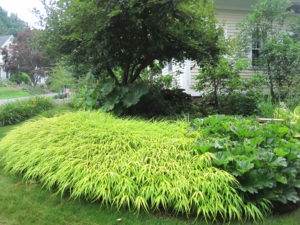Kowhai Thompson’s first landscape design instalment
Mass Planting
 One way to create a ‘tied together’ look in your home garden is to add areas of mass plantings. This works both for brand new gardens and for established gardens. Think of purchasing 5 or 10 identical plants at a time of the same variety/colour at a garden centre. Many gardens develop in a piecemeal way over time and can look a bit disorganised.
One way to create a ‘tied together’ look in your home garden is to add areas of mass plantings. This works both for brand new gardens and for established gardens. Think of purchasing 5 or 10 identical plants at a time of the same variety/colour at a garden centre. Many gardens develop in a piecemeal way over time and can look a bit disorganised.
Do you have a garden with lots of small shrubs? Grow one kind of ground cover underneath them and create a carpet of foliage to tie the look together. Good options are Ajuga, Veronica, or Alyssum. Or do you have a large collection of annuals? Grow a low hedge behind to frame them such as Teucrum, Escallonia or Camellia fairy blush. Or perhaps your garden is very low in height overall. You can plant some small trees, such as three Pseudopanax arboreus – coastal five finger. Creating a more planned and purposeful look can be as simple as planting some mass groupings in your garden.
Introduction to Permaculture
What is permaculture? Developed by Bill Mollison and David Holmgren in the 1970s, permaculture is the creation of ecological systems and self maintaining habitats. One of the most popular design ideas is the food forest, a type of horticulture that involves intelligent landscape design. Vegetables, herbs, fruit trees and nut trees are grown in such a way that makes efficient use of space, and where possible support each others growth. For example mint can be grown in the shade under fruit trees. Permaculture gardens generally look more organic and rambling than a regular vegetable patch, but with the addition of some raised beds and creative layout, a permaculture garden will have it’s own charm. Furthermore a food forest will be teaming with food, insects and life. Children will love fossicking about for treats like cherry tomatoes and strawberries in this exciting space.
Another useful permaculture concept is the idea of garden zones. The landscape is divided into areas, with zone 1 being closest to the home. Permaculture recognises human nature, we are less likely to walk to the end of the garden to pick chives for a salad, especially if it’s raining! But if the herb garden is right outside the kitchen door then we will use our herbs more. Therefore the kitchen garden is placed into zone 1. Read more about zones by following this link:
www.permaculture.wikia.com/wiki/Zones_(Permaculture)

